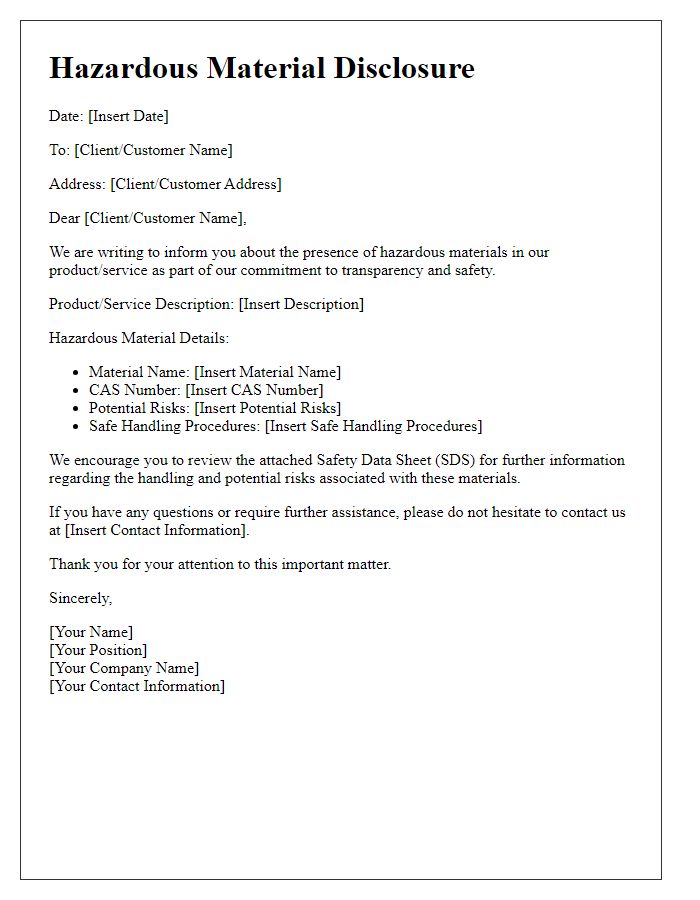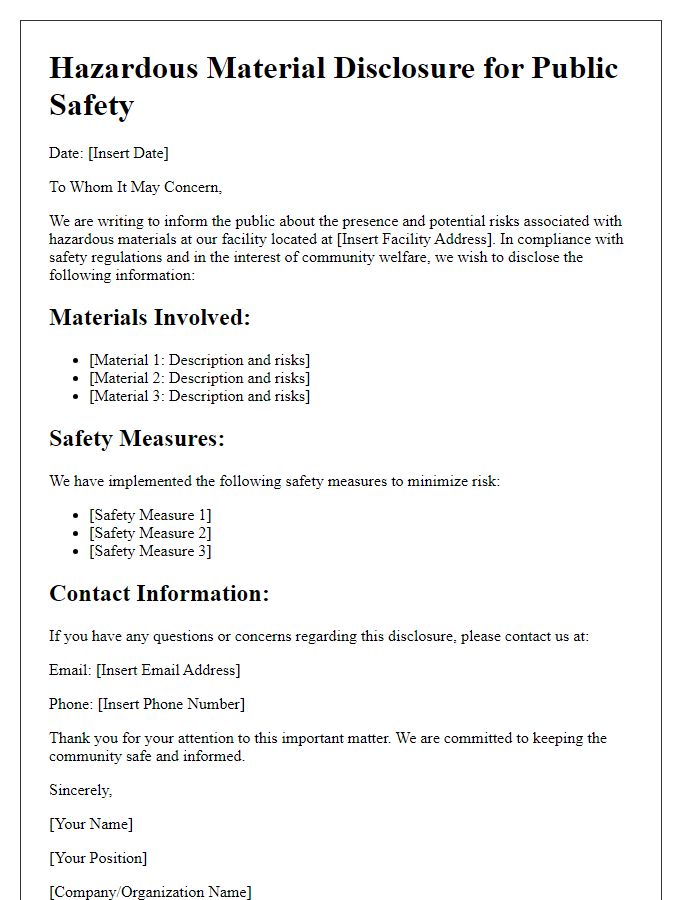Are you navigating the complexities of hazardous material disclosure? It's essential to understand the requirements and best practices for communicating potential risks effectively. In this article, we'll break down the key elements of a well-crafted letter template, ensuring you cover all necessary points while keeping it straightforward and compliant. Join us as we explore how to convey critical information with clarity and confidenceâread on for valuable insights!

Accurate Identification of Hazardous Materials
Accurate identification of hazardous materials is essential for ensuring safety in workplaces and environmental protection. Hazardous materials, defined by agencies such as OSHA (Occupational Safety and Health Administration) and EPA (Environmental Protection Agency), include substances that can pose significant risks to health, safety, or the environment. Examples include asbestos, lead-based paints, and volatile organic compounds (VOCs), commonly found in industrial settings and homes. Proper labeling, such as the Globally Harmonized System (GHS) pictograms, provides critical information about chemical properties and safety measures. Regular audits and inventory checks, mandated by federal regulations, help maintain compliance and reduce the likelihood of exposure incidents. Effective employee training programs are crucial in educating workers about the risks associated with these materials, proper handling procedures, and emergency response protocols, thereby fostering a culture of safety and awareness in facilities dealing with hazardous substances.
Potential Health and Safety Risks
Hazardous materials, such as asbestos and lead, present significant health and safety risks in various environments including construction sites and older buildings. Exposure to asbestos fibers, which can become airborne during renovation efforts, may lead to serious respiratory issues, including asbestosis and lung cancer. Lead, commonly found in older paints and plumbing systems, poses risks such as neurological damage and developmental issues in children when ingested or inhaled. Regulatory institutions, like the Environmental Protection Agency (EPA), establish clear guidelines regarding permissible exposure limits and proper handling procedures to mitigate these hazards. It is crucial for workers and residents to adhere to safety protocols, including the use of personal protective equipment (PPE) and proper ventilation, to minimize risks and ensure overall safety.
Detailed Handling and Storage Instructions
Hazardous materials, such as chemicals classified under the OSHA Hazard Communication Standard, require specific handling and storage instructions to minimize risk. Proper labeling of containers is crucial; use clear hazard symbols and signal words (e.g., "Danger," "Warning"). Store hazardous materials, like flammable liquids, in approved fire-safe cabinets designed for their specific categories. Ensure ventilation in storage areas, particularly for volatile substances, while maintaining a temperature range of 15 to 25 degrees Celsius to prevent degradation. Personal protective equipment (PPE), including gloves and goggles, must be readily available during handling to protect against exposure. Regular training sessions for employees on emergency procedures should be scheduled to reinforce safety protocols and response to incidents, ensuring compliance with regulations established by agencies such as the Environmental Protection Agency (EPA).
Emergency Response Procedures
Hazardous materials (such as chemical agents like chlorine or biological agents like anthrax) require strict emergency response procedures to protect human health and the environment. The initial response protocol includes assessing the situation, identifying the hazardous material through labeling or Material Safety Data Sheets (MSDS), and isolating the area to prevent exposure. Personal Protective Equipment (PPE), including gloves, goggles, and respirators, must be worn by responders. At the site of a hazardous material spill or leak (often designated with specific emergency contact numbers), trained professionals must conduct decontamination processes to safeguard both personnel and surrounding communities. Proper disposal methods must follow local environmental regulations for hazardous waste management, with facilities such as designated landfills or incinerators complying with federal standards. Regular training and drills in facilities, workplaces, or local emergency services ensure readiness and quick response during actual emergencies.
Compliance with Relevant Regulations and Standards
Hazardous material disclosure is essential for compliance with relevant regulations and standards such as OSHA (Occupational Safety and Health Administration) and EPA (Environmental Protection Agency). Companies handling hazardous substances, like solvents or heavy metals, must adhere to established guidelines for labeling, storage, and employee training. The Material Safety Data Sheet (MSDS) provides critical information on the effects of exposure, safe handling practices, and emergency procedures for materials like asbestos or lead. Failure to comply with these regulations can result in significant penalties, health risks for workers, and environmental damage, underscoring the importance of meticulous and transparent disclosure in promoting safety and regulatory adherence.
Letter Template For Hazardous Material Disclosure Samples
Letter template of hazardous material disclosure for emergency responders.

Letter template of hazardous material disclosure for clients and customers.

Letter template of hazardous material disclosure for regulatory compliance.

Letter template of hazardous material disclosure for public safety announcements.

Letter template of hazardous material disclosure for facility inspections.

Letter template of hazardous material disclosure for incident reporting.








Comments